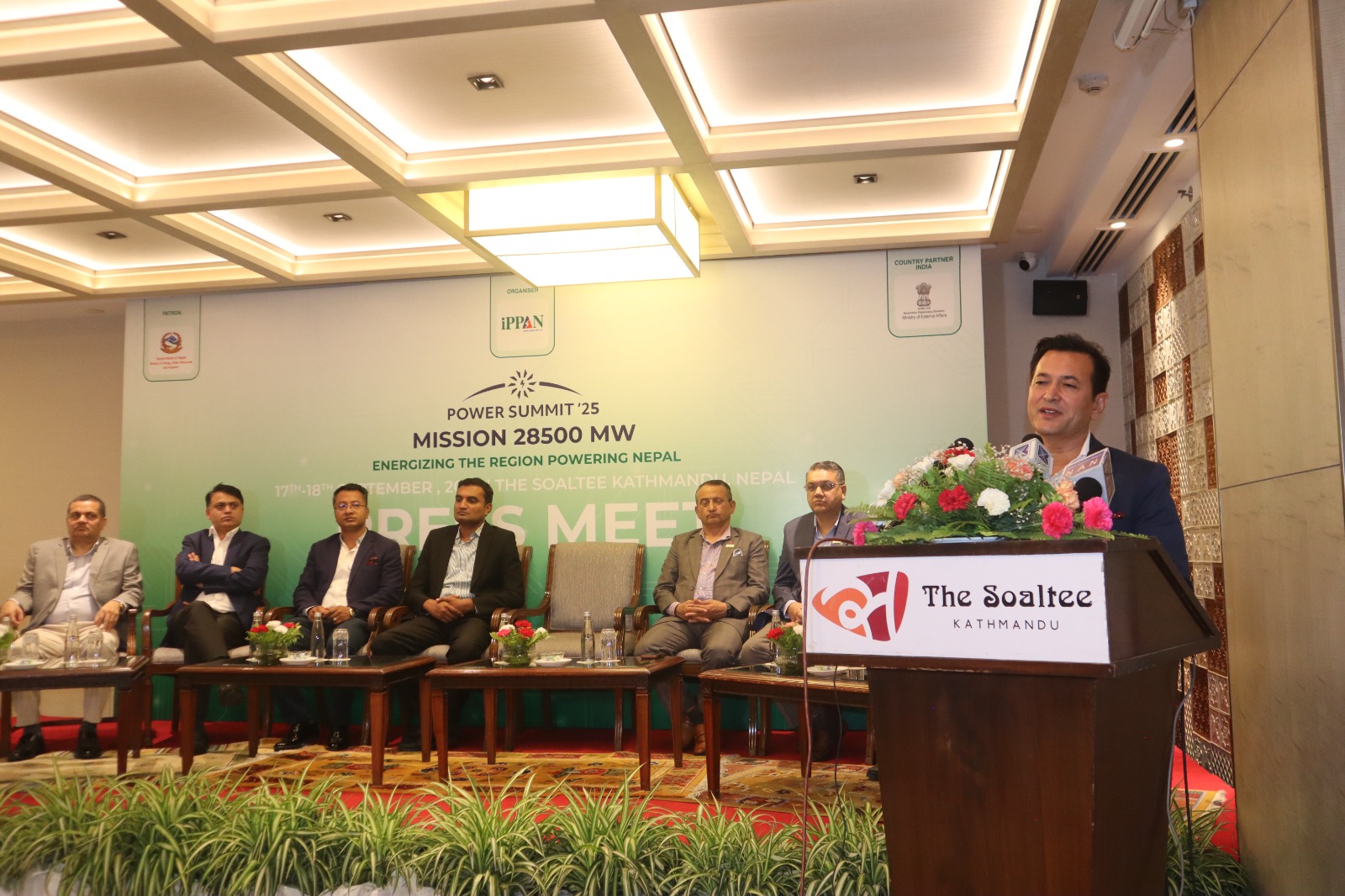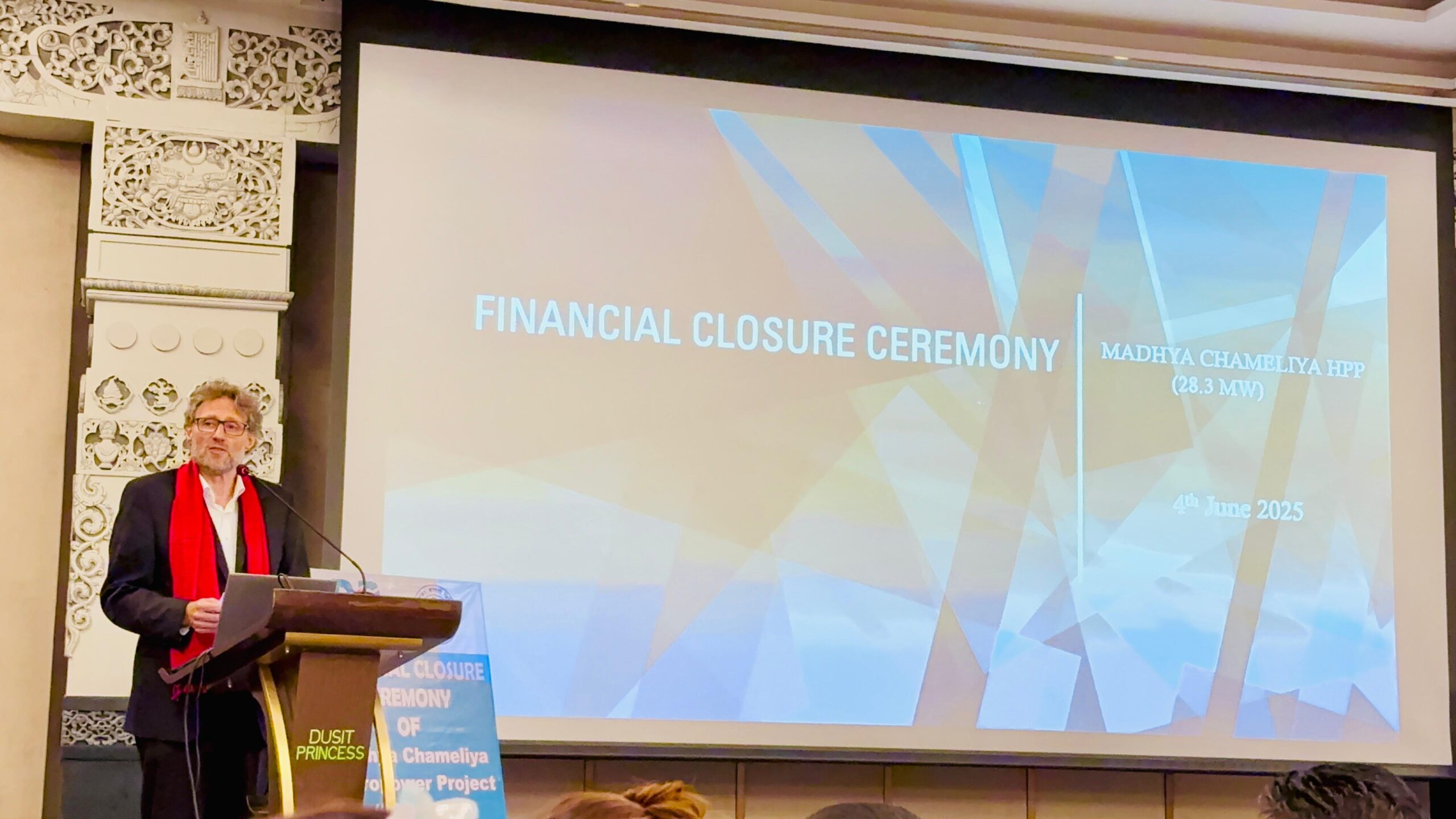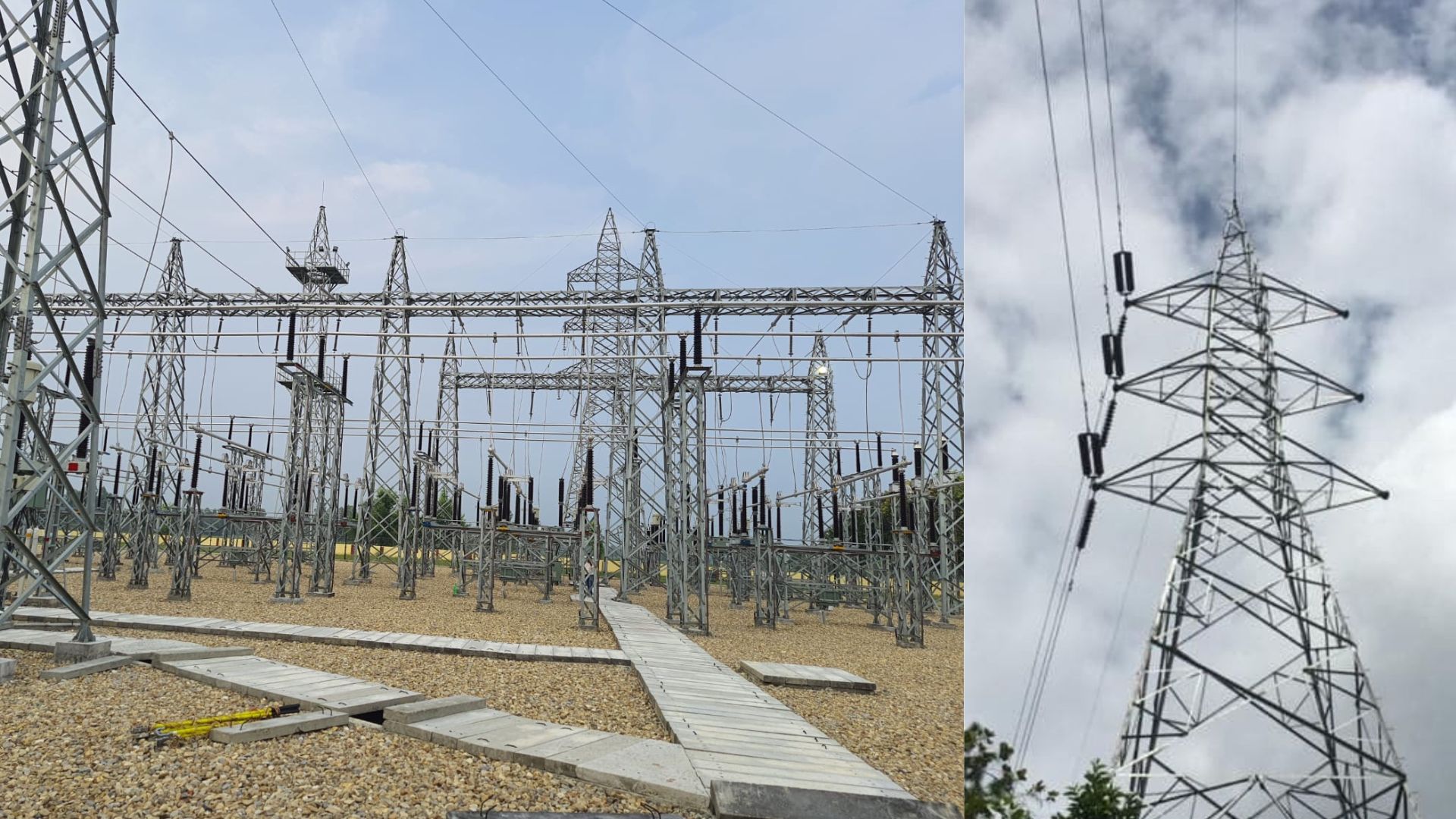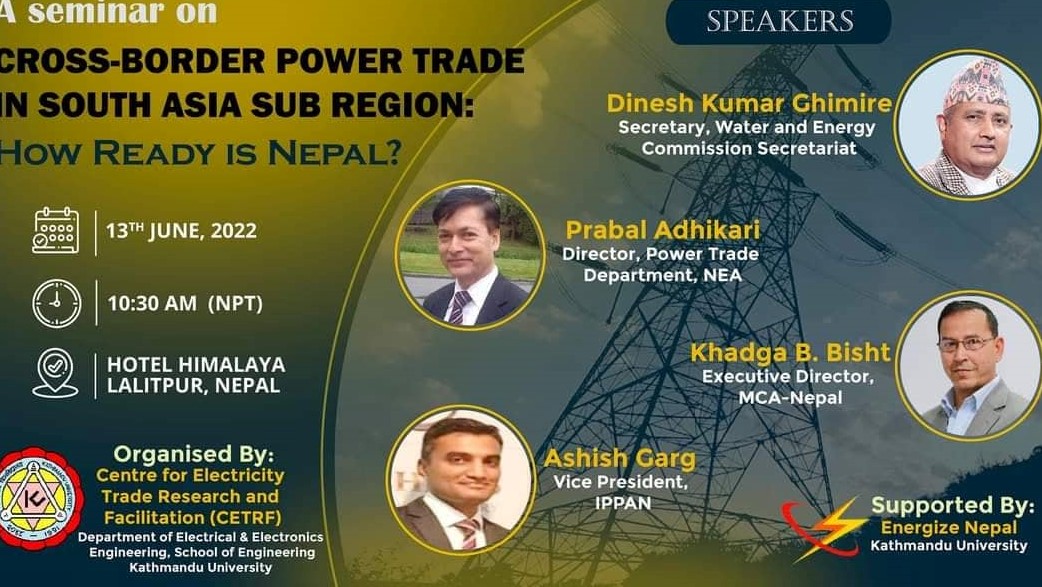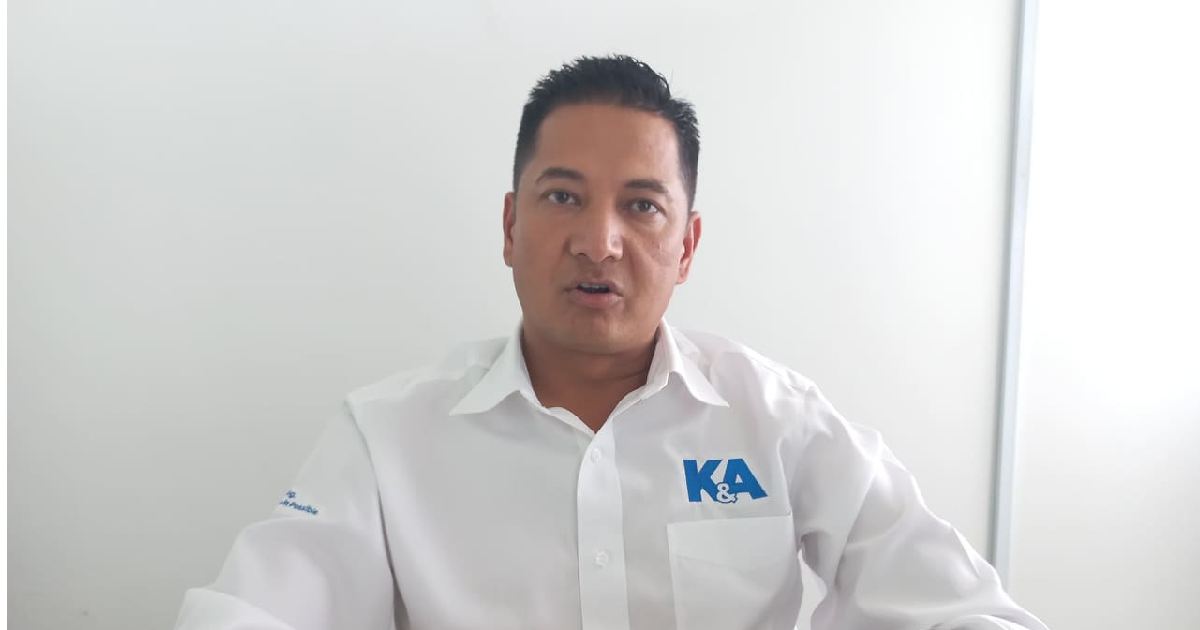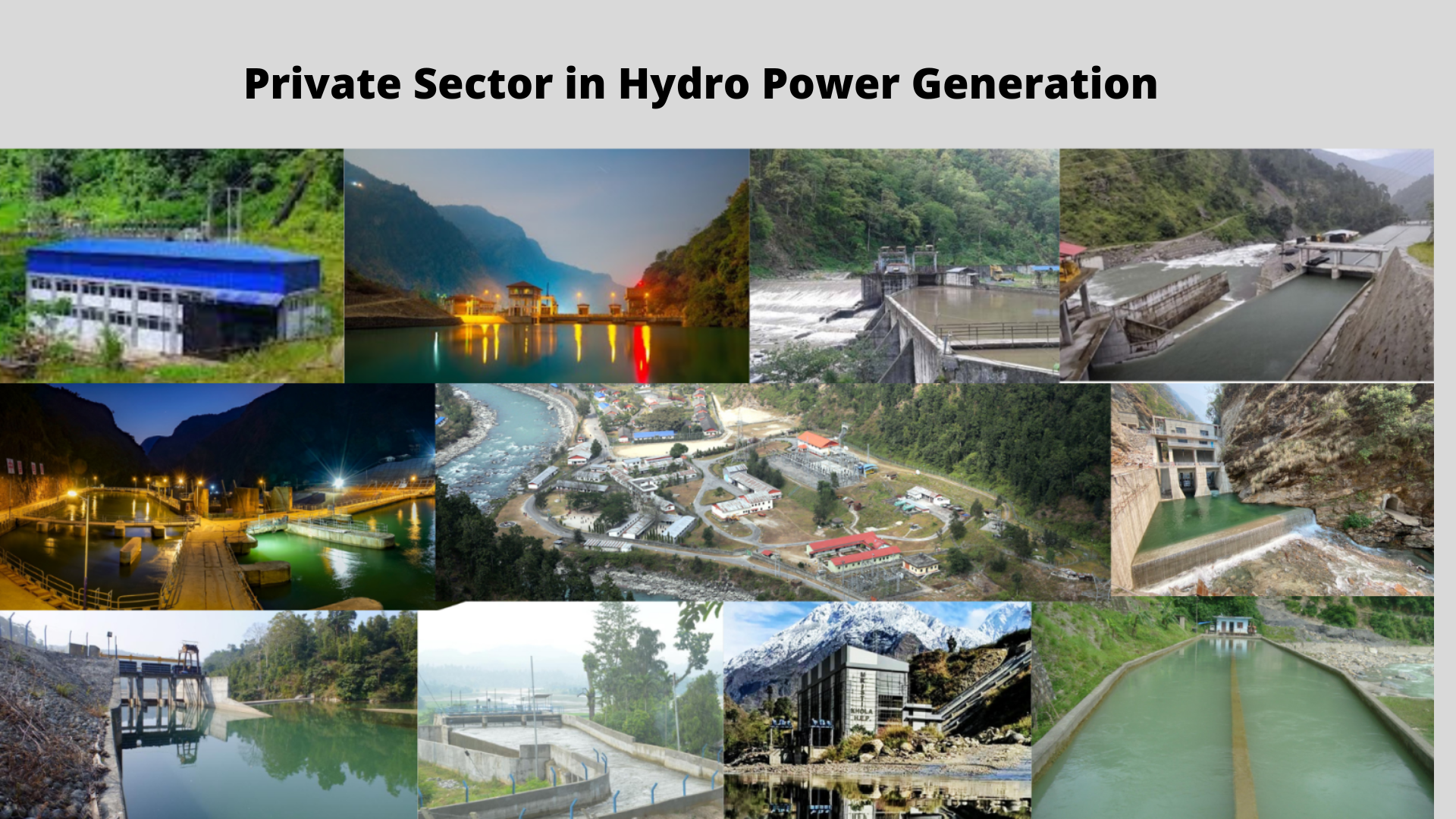
 KATHMANDU: Up until 1990 when multiparty democracy was restored in Nepal, total electricity generation was hardly 176 MW with private sector contribution of only 9.4 MW. Almost a decade later, the budget for the fiscal year 2000/01 announced that electricity generation in the country would be increased to 352 MW. Electricity Act 1992 and the Power Purchase Agreement (PPA) in 2000 were brought a significant mode to promote the participation of the private sector in electricity generation.
KATHMANDU: Up until 1990 when multiparty democracy was restored in Nepal, total electricity generation was hardly 176 MW with private sector contribution of only 9.4 MW. Almost a decade later, the budget for the fiscal year 2000/01 announced that electricity generation in the country would be increased to 352 MW. Electricity Act 1992 and the Power Purchase Agreement (PPA) in 2000 were brought a significant mode to promote the participation of the private sector in electricity generation.
During the last 110 years, 561 MW has been generated through the government initiative while the private sector managed to produce 1500 MW of electricity only after 2000. Of the total generation from the private sector, subsidiary companies of Nepal Electricity Authority (NEA) generated 500 MW.
Before the Electricity Act, 1992 was introduced, the Tinau hydropower project of one megawatt was built by the private sector. However, the then rules did not allow the private sector to operate hydropower projects. Hence, the project was nationalized and handed over to the NEA. On August 17, Kulman Ghising submitted a report and announced that the private sector has produced a total of 1,532 MW, including about 30 MW of solar and bagasse electricity.
“During the last fiscal year 2021, the private sector has produced 717 MW from 24 hydropower projects, of which 478 MW is owned by the NEA’s subsidiary companies”

Director General of the Department of Electricity Development (DoED) Sandeep Dev also says that there are currently 19,000 MW projects, for which 14,000 survey permits have been issued and 5,000 MW applied for production permits, which belong to the private sector.
The interest of the private sector has also started to be seen in reservoir projects in recent years. Recently, the private sector has applied for a survey permit for the 300 MW Bheri-4 reservoir project, and the process of issuing the permit has started.
“It is also a positive thing that the private sector is willing to build a storage project”

The biggest project is the 456 MW hydropower project, which is also considered a private sector project. Similarly, the largest project built with the participation of the private sector in foreign investment is Khimti of 60 MW and Likhu-4 of 52.4 MW built with domestic investment.
According to the Nepal Electricity Authority (NEA), among the 3131 MW projects under construction, the 216 MW Upper Trishuli-1 project is being built by the private sector with foreign investment, while the 99.4 MW Lapchekhola project is being built by the domestic private sector.
The private sector has produced almost two-thirds of the total production since the government took the path of liberalization in power generation.
Krishna Acharya, Chairman of the Independent Power Producer’s Association (IPPAN), says that the private sector accounts for two-thirds of the country’s total energy production. ” Even now, the private sector is making hydropower projects with great difficulty frequenting seven ministries and 22 departments. However, the private sector is leading this sector,” says Acharya.
“Even now, the private sector is making hydropower projects with great difficulty frequenting seven ministries and 22 departments. However, the private sector is leading this sector”

It is considered that the liberal policy adopted by the then government after the multi-party democracy is behind the fact that the private sector was able to produce the electricity that the government could not produce in 110 years.
Priorities after multiparty democracy
In the budget presented by the then Finance Minister Dr. Devendra Raj Pandey in the year 1990, the budget for the financial year 1990/91 did not accord priority to the promotion of hydropower by the private sector. But the budget of the year 1991/92 presented by the then Minister of State for Finance Mahesh Acharya in 1991, mentioned that the policy of encouraging the private sector will also be adopted in the program of small hydropower generation.
While presenting the budget 1994 for the year 1993/94, Minister of State for Finance Acharya said that the government’s attention will be focused on the development of hydropower in the coming days and stated that projects like Khimti, Modi Khola, Bhotekoshi, and West Seti will be promoted by the private sector. It was also mentioned in the budget that as a result of the policy of promoting the investment of the private sector for the proper development of water resources, an agreement has been reached for the construction of the Khimti hydropower project in joint investment.
In 1995, while presenting the budget for the year 1996/97, the then Finance Minister Bharat Mohan Adhikari stated that energy should be the second priority sector after agriculture in the context of Nepal. However, the budget did not speak about the involvement of the private sector. Then Finance Minister Dr. Ramsharan Mahat said since the private sector is enthusiastically involved in the implementation of the Khimti and Bhote Koshi hydropower projects, it will be officially involved in the implementation of other potential projects as well. In the same budget, the government had announced that considering the demand for electricity in the border areas of the neighboring country India, there are many possibilities to export electricity.
Presenting the budget for the year 1997/98 in 1997, the then finance minister Rabindranath Sharma mentioned that the private sector was going ahead with the operation of the 750 MW West Seti hydropower project to export electricity abroad.
That initiative of Odd Hofton

In 1958, Norway’s hydroelectric engineer Odd Hofton came to Nepal to build Tansen’s hospital. According to Hydropower Nepal written by the former president of IPPAN, Khadga Bahadur Bisht, he tried to start a hydropower project by the private sector for the first time in Nepal by building a one megawatt Tinau project for the Butwal Technical Institute, which was operating with diesel.
However, the rules did not allow the private sector to build a hydroelectric project. Hence the NEA was given the responsibility of its operation. After that, he not only helped in the construction of Jhimruk and Andhi Khola projects but also contributed greatly to the Khimti project.”Wad Hofton showed that it is possible to generate electricity from the private sector in Nepal before the multi-party democracy.
After democracy, the government’s liberal policy with the involvement of the private sector has shown it in a big way in the field of hydropower,” Bisht says. It is such that the production of the private sector has not only supported ending load shedding but has also made a great contribution to energy security.’
Historic June 28, 1998
June 28, 1998, was the day when the PPA rate was fixed for the first time in the history of Nepal. The credit goes to the then Deputy Prime Minister and Water Resources Minister Shailaja Acharya.
“Before the rate of PPA was fixed, we had done PPA in some projects but there was confusion when the rate was not decided”

Although the Electricity Act 2049 opened up the entry of the private sector, the hydropower project could not proceed because the government did not guarantee the purchase of electricity. Till then, the PPA of 60 MW Khimti, 45 MW Upper Bhotekoshi, and 7.5 MW Indravati III already had PPA, but the rate of PPA was not fixed.”We had done PPA for some projects before the rate of PPA was fixed, but there was confusion when the rate was not decided,” says Krishna Prasad Bhandari, a hydropower promoter who is also active in the construction of Indravati-3.
As the PPA rates were not finalized, there were problems such as loans from banks, and the promoters of the private sector were pressing the Ministry for PPA. The then Energy Minister Acharya, who was positive about the demand of the private sector, directed the NEA’s board of directors to set the PPA rate for the first time for 1 to 10 megawatts Q90 at Rs 2.76 per unit during the rainy season and Rs 4.03 per unit during the winter. After the complaint from the private sector that the project could not be made in Q90, Acharya again reduced it to Q65 and the PPA rate was fixed at Rs 4.25 per unit for winter and Rs 3 per unit for the rainy season. This decision became a game-changer for the entry of the private sector into hydropower.
“That decision of the then Minister Acharya opened the door for private hydropower promoters in Nepal. Initially, it was said that only up to 10 MW would be given because the private sector could not build it, now the private sector has been forced to build large projects”

After this decision, the first PPA of 0.183 MW in Lamjung was done by Sange Khola on 16 January 2002 with Pradhirkaran. “That decision of the then Minister Acharya opened the door for private hydropower promoters in Nepal. At first, it was said that only up to 10 MW would be given because the private sector could not build it, now the private sector is restricted even to building big projects” – says Kumar Pandey, advisor of the IPPAN, “The authority will buy electricity. The assurance encouraged both the lending banks and investors.”
Liberal government policies, private sector capacity building
The open policy adopted by the government became the biggest opportunity for private promoters to invest in hydropower. Initially, the private sector could only build up to 10 MW, the government gave the private sector the opportunity to build any scale of the project.
In the high-risk, high-cost, and time-consuming hydropower sector, the government’s rescue policy towards the private sector not only transfers risks to the private sector but also increases its ability to invest”

Ashish Garg, Chairman of the Infrastructure Committee of Confederation of Nepalese Industries and Vice Chairman of IPPAN, says that the private sector has made an unexpected leapfrogging in production.
“All over the world energy production is mostly done by government bodies, but in Nepal, more than 50 percent of the production is done by the private sector. This is not only a great achievement; it is a leap forward in the energy sector.
There is no such progress in any other infrastructure sector in Nepal. He says that the government’s rescue policy towards the private sector in the hydropower sector, which has more risks and takes more time and cost, not only increased the risk-bearing capacity of the private sector but also increased the ability to invest.
“The production has not only given light to the country, but the hydropower sector has also been established as the only industry to maintain fiscal balance in the country,” –

Shailendra Guragai, former president of IPPAN, said the private sector has been able to make great progress due to the environment of open competition worldwide. He said, “Production has not only given light to the country but the hydropower sector has also been established as the only industry to maintain financial balance.
“To produce so much in such a short period of time is the success of the private sector, the government should provide a proper environment and facilitation for the investors”

The hydroelectric power sector is really attractive for investment. The private sector has moved forward and now it has barely moved to the left, according to the analysis of hydropower promoter Guru Neupane.
“In Nepal, it has been recognized that hydropower is a suitable area for investment, the interest of investors has increased, and everyone is interested in it,” he says. It is through this sector that the country’s economy takes a leap forward through a proper environment and facilitation.
In other infrastructure sectors including roads, there is no guarantee of market and returns, but in the hydropower generation sector, the government has made a guarantee of purchase.
“We have always been facilitating the private sector for hydropower production, the government has also given a guarantee to buy electricity. This is a great help from the government”

Madhu Bhetuwal, Joint Secretary and Spokesperson of the Ministry of Energy, Water Resources and Irrigation, says that the government is facilitating the private sector. “We have always been facilitating the private sector for hydropower production, the government has also given a guarantee to buy electricity. This is a great help from the government,” says Bhetuwal.
Some of the events have made their special marks in Nepal’s hydropower development.
First event:
After the construction of 144 MW Kaligandaki, the Nepal government sent a team to India to sell electricity, but the mission could not succeed. Immediately after this, there was an extreme problem of load shedding. During load shedding around 2004, private sector investors were clamoring to get permits, while the NEA remained silent after Kaligandaki’s case. The situation of load shedding has become a great opportunity for the private sector to build hydropower projects. During this period, various packages were announced to give concessions to the private sector by the government.
Second event:
5 years ago, the energy crisis in Nepal increased after the blockade by the Indian government. After this, the issue of energy security and self-reliance was raised vigorously. Nepal Oil Corporation, which does not have storage capacity even for two weeks, proceeded with the construction of a structure for storage capacity of up to 90 days. It was decided that there would be no energy security until hydroelectricity generation is promoted. During this period, Nepal Rastra Bank also brought a plan to increase hydropower investment. This is also the reason why the private sector’s hydroelectricity production was boosted.
Third event:
Last year, Nepal got the opportunity to export electricity to the Indian market. Although the Power Trade Agreement (PTA) was signed between Nepal and India 8 years ago, it took shape only last year. The electricity business in the Indian market, which started with an export of 39 MW, has now reached 364 MW. The private sector is asking for permission for electricity trade, while the NEA has been stating that it can export up to 1,000 MW next year. This event is also encouraging private sector power generation. In the meantime, Covid-19 has made the use of information technology and the importance of electricity even more urgent.
“Incidents like blockade and load shedding gave a message that the private sector should be encouraged and facilitated for production, and the private sector also moved forward accordingly”

Some of these developments have encouraged the private sector. The former president of IPPAN believes that the changes in politics and the developments of the time have also promoted the private sector. “Incidents like blockade and load shedding gave the message that the private sector should be encouraged and facilitated for production. The private sector also moved ahead accordingly,” he says.
The success achieved by the private sector in the hydropower sector in three decades is something to be proud of. Nepal’s private sector should not stop at this. Many people expect that if they can cooperate with the government to create a favorable environment for electricity export, it will contribute significantly to reducing the country’s growing trade deficit and increasing foreign exchange reserves.
Name of project completed so far, district, capacity and year
2057
| Project | District | Capacity(MW) |
| Khimti River | Dolkha | 60 |
| Upper Bhotekoshi | Sindhupalchowk | 45 |
| Total | 105 |
2058
| Project | District | Capacity(MW) |
| Sange river | Lamjung | 0.183 |
| Jhrimuk river | Pyuthan | 12 (pre construction, post PPA only) |
| AadhiKhola | Syangja | 9.4 12 (pre-build, post PPA only) |
| Total | 21.583 |
2059
| Project | District | Capacity(MW) |
| Indrawati third | Sindhupalhowk | 7.5 |
| Total | 7.5 |
2060
| Project | District | Capacity(MW) |
| Chilime | Rasuwa | 22.100 |
| Piluwakhola Sana | Sankhuwasabha | 3 |
| Total | 25.1 |
2062
| Project | District | Capacity(MW) |
| Rairang river | Dhading | 0.5 |
| Sunkoshi Sana | Sindhupalchowk | 2.5 |
| Total | 3 |
2062
| Project | District | Capacity(MW) |
| Chaku Khola | Sindhupalchowk | 3 |
| Total | 3 |
2063
| Project | District | Capacity(MW) |
| Khudi Khola | Lamjung | 4 |
| Baramchi Khola | Sindhupalchowk | 2.5 |
| Total | 6.5 |
2064
| Project | District | Capacity(MW) |
| Thople Khola | Dhading | 1.650 |
| Sisre Khola Sana | Palpa | 0.750 |
| Salinadi | Kathmandu | 0.250 |
| Feme Khola | Pachthar | 0.995 |
| Total | 3.645 |
2065
| Project | District | Capacity(MW) |
| PatIKhola Sana | Parwat | 0.996 |
| Seti 2 | Kaski | 0.979 |
| Total | 1.975 |
2066
| Project | District | Capacity(MW) |
| Ridi Khola | Gulmi | 2.4 |
| Upper HadiKhola | Sindhupalchowk | 0.991 |
| Mardi Khola | Kaski | 4.8 |
| Total | 8.191 |
2067
| Project | District | Capacity(MW) |
| Mai Khola | ilam | 4.5 |
| Total | 4.5 |
2068
| Project | District | Capacity(MW) |
| Lower Piluwa Khola | Sankhuwasabha | 0.990 |
| Hewa Khola | Sankhuwasabha | 4.455 |
| Total | 5.445 |
2069
| Project | District | Capacity(MW) |
| Bijayapur | Kaski | 4.410 |
| Siure Khola | Lamjung | 4.950 |
| Lower Modi 1 | Parwat | 10 |
| Spring Khola | Dolakha | 1.658 |
| Middle Chaku | Sindupalchowk | 1.800 |
| Tadi Khola | Nuwakot | 5 |
| Total | 35.818 |
2070
| Project | District | Capacity(MW) |
| Aakhukhola-1 | Dhading | 8.4 |
| Charnawati | Dolakha | 3.520 |
| Lower Chaku Khola | Sindupalchowk | 1.800 |
| Total | 13.720 |
2071
| Project | District | Capacity(MW) |
| Bheruwa Kunda | Sindupalchowk | 3 |
| Radi Khola | Lamjung | 4.400 |
| Mailung Khola | Rasuwa | 5 |
| Chote Khola | Gorkha | 0.993 |
| Upper Puwa -1 | ilam | 3 |
| Mai Khola | ilam | 22 |
| JireKhola Sana | Dolakha | 2.200 |
| Upper Hugdi Khola | Gulmi | 5 |
| Belkhu | Dhading | 0.528 |
| Total | 46.111 |
2072
| Project | District | Capacity(MW) |
| Naugadh Khola | Darchula | 8.5 |
| Susma Bukhri | ilam | 0.998 |
| Mai Cashket | ilam | 7 |
| Chandi | Lamjung | 2 |
| Total | 18.498 |
2073
| Project | District | Capacity(MW) |
| Upper Mai Khola | ilam | 9.980 |
| Daram Khola A | Baglung | 2.5 |
| Jyamdi Khola | Sindhupalchowk | 2 |
| Tungun Thosre | Lalitpur | 4.360 |
| Daraudi Khola A | Gorkha | 6 |
| Khani Khola | Lalitpur | 2 |
| Miya Khola | Khotang | 0.996 |
| Upper Marsyangdi A | Lamjung | 50 |
| Upper Madi | Kaski | 25 |
| Hewa Khola A | Pachthar | 14.900 |
| Total | 47.26 |
2074
| Project | District | Capacity(MW) |
| Jomai | ilam | 7.6 |
| Dwarikhola | Dailekh | 3.750 |
| Trapur Mai Si | ilam | 5.1 |
| Dhunge Jire | Dolakha | 0.6 |
| Sabhakhola | Sankhuwasabha | 4 |
| Puwa Khola 1 | ilam | 4 |
| Fawa Khola | Tapljung | 4.950 |
| Thapa Khola | Myagdi | 13.600 |
| Sardi Khola | Kaski | 4 |
| Chake Khola | Ramechhap | 2.830 |
| Midim Karpu | Lamjung | 3 |
| Syari Bhumai | Nuwakot | 0.23 |
| Melungkhola | Okhaldhunga | 7 |
| Markhukhola | Kaski | 13 |
| Mai Sana Cashcate | ilam | 8 |
| Total | 83.660 |
2075
| Project | District | Capacity(MW) |
| Theulekhola | Baglung | 1.500 |
| Leguwakhola | Dhankuta | 0.40 |
| Super Mai | ilam | 7.8 |
| Sebuba Khola 2 | Taplejung | 0.90 |
| Midim Khola | Lamjung | 0.100 |
| Rudikhola A | Lamjung and Kaski | 8.8 |
| Bagmati khola sana | Makwanpur/Lalitpur | 22 |
| Total | 49.500 |
2076
| Project | District | Capacity(MW) |
| Khaptad Gada | Doti | 3.33 |
| Pikhuwa Khola | Bhojpur | 5 |
| Lower Hewakhola | Pachthar | 22.1 |
| Layer Short River | Gorkha | 0.997 |
| Upper Mardi | Kaski | 7 |
| Ewa Khola | Taplejung | 9.9 |
| Upper Nalgad | Darchula | 8 |
| Kabeli B 1 | Taplejung/ Pachthar | 25 |
| Jelyugada | Bajhang | 0.996 |
| Padamkhola | Dailekh | 4.80 |
| Rudi Khola B | Lamjung/Kaski | 6.6 |
| Ghalendo khola | Myagdi | 5 |
| Upper Khorunga | Terhathum | 7.5 |
| Solukhola | Solukhumbu | 23.5 |
| Total | 129.723 | |
2077
| Project | District | Capacity(MW) |
| Super mai | A ilam | 9.6 |
| Super mai Cascate | ilam | 3.8 |
| Hadikhola Sunkoshi A | Sinhupalchowk | 0.997 |
| Upper Rawa | Khotang | 3 |
| Namarjun Mardi | Kaski | 11.88 |
| Ghattekhola | Dolakha | 5 |
| Bijayapur 2 | Kaski | 4.5 |
| Total | 39.677 |
2078
| Project | District | Capacity(MW) |
| Taksar Piluwa | Pikhuwa Bhojpur | 8 |
| Upper Chaku A | Sindhupalchowk | 22.2 |
| Mistrikhola | Myagdi | 42 |
| Singti | Dolakha | 25 |
| Richet Khola | Gorkha | 4.98 |
| Upper Tamakoshi | Dolakha | 456 |
| Maibeni | ilam | 9.41 |
| Lower Modi | Parwat | 20 |
| Lower Jogmai | ilam | 6.2 |
| Likhu 4 | Ramechhap | 52.4 |
| Upper Chyangdi | Lamjung | 4 |
| Lower Khare | Dolakha | 11 |
| Sapsup river | Khotang | 6.60 |
| Linkhu Khola A | Solu/Ramechhap | 24.2 |
| Upper Syage River | Lamjung | 2.4 |
| Lear Tadi | Nuwakot | 4.993 |
| Cabelli B 1 | Pahthar | 9.94 |
| Upper Hewa Khola Sana | Sankhuwasabha | 8.5 |
| Total | 717.423 |
2079 (until now)
| Project | District | Capacity(MW) |
| SuriKhola | Dolakha | 6.4 |
| Nyadi | Lamjung | 30 |
| Upper Khimti | Ramechhap | 12 |
| Upper Khimti 2 | Ramechhap | 7 |
| Total | 55.4 |
Source: Nepal Electricity Authority
Official
| Project | Year | District | Capacity(MW) |
| Pharping | 9th June 1968 | Kathmandu | 0.5 |
| Sundarijal | 1992 | Kathmandu | 0.640 |
| Panauti | 2022 | Kavre | 2.4 |
| Trishuli | 2024 | Nuwakot | 24 |
| Fewa | 2026 | Kaski | 1 |
| Sunkoshi | 2029 | Sipa | 10.050 |
| Gandaki | 2035 | Nawalparasi | 15 |
| Tinahu | 2038 | Palpa | 1.024 |
| Kulekhani first | 2039 | Makwanpur | 60 |
| Devghat | 2041 | Nuwakot | 14.100 |
| seti | 2042 | Kaski | 1.5 |
| Kulekhani second | 2043 | Makwanpur | 32 |
| Tatopani | 2045 | Sipa | 2 |
| Total | 167.474 |
After 2046 years
| Project | Year | District | Capacity(MW) |
| Masyangdi | 2046 | Tanahun | 6.9 |
| Modi Khola | 2057 | Parwat | 14.800 |
| Kaligandaki A | 2059 | Syangja | 144 |
| Poowa | 2060 | ilam | 6.2 |
| Madhyamsyangdi | 2064 | Lamjung | 70 |
| Chamelia river | 2074 | Darchula | 30 |
| Kulekhani third | 2076 | Makwanpur | 14 |
| Upper Trishuli 3A | 2076 | Nuwakot | 60 |
| Total | 408 |
Source: Department of Power Development
Private sector licensing conditions
| Permit | Capacity (MW) | Body |
| Survey | 8573 | Private |
| 5216 | (Government, Authority and Subsidiary Company) | |
| Survey application | 702 | Private |
| 0 | (Government, Authority and Subsidiary Company) | |
| Construction
|
7723 | Private |
| Construction application | 461 | (Government, Authority and Subsidiary Company) |
| Total | 3035 | Private |
| Private | 2697 | (Government, Authority, and Subsidiary Company) |
| 28407 | ||
| 20033 | ||
| (Government, Authority, and Subsidiary Companies) | 8374 |
Source: Department of Power Development


